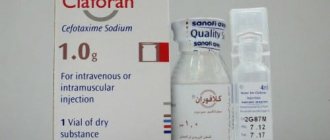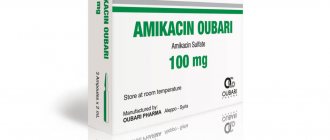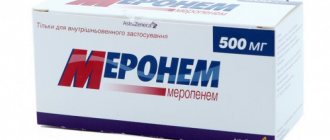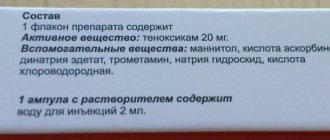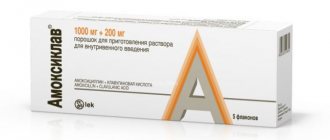Instructions for use CEFEPIM (CEFEPIME)
Warnings:
Before starting the use of cefepime for injection, it is necessary to find out whether the patient has had hypersensitivity reactions to cefepime, cephalosporins, penicillins or other drugs. If the drug must be administered to patients with hypersensitivity to penicillins, caution should be exercised as cross-hypersensitivity among beta-lactam antibiotics has been reported and may occur in up to 10% of patients with a history of penicillin allergy. If an allergic reaction to cefepime develops, you must stop using the drug. Severe acute hypersensitivity reactions may require the use of epinephrine and other emergency measures, including oxygen, corticosteroids, plasma replacement solutions, IV antihistamines, and, depending on the clinical situation, pressor amines, airway management.
In patients with impaired renal function (creatinine clearance 60 ml/min or less), the dose of cefepime should be adjusted to compensate for the low rate of its excretion by the kidneys. Because high and prolonged serum concentrations of the antibiotic may occur in patients with renal failure or other conditions that may impair renal function at normal doses, the maintenance dose of cefepime should be reduced in such patients. The degree of renal impairment, the severity of the infection and the sensitivity of the microorganisms causing the infection should be taken into account when determining the subsequent dose. During post-registration observations of the drug, severe side effects were reported, including life-threatening or fatal cases:
- encephalopathy (impaired consciousness, including confusion, hallucinations, stupor and coma), myoclonus and seizures. Most cases were reported in patients with impaired renal function who were administered cefepime in doses higher than recommended. However, isolated cases of encephalopathy have been observed in patients receiving doses adjusted based on their renal function. In most cases, symptoms of neurotoxicity were reversible and resolved after discontinuation of cefepime and/or hemodialysis.
Almost all antibacterial drugs, including cefepime, can cause pseudomembranous colitis, which can range in severity from mild to life-threatening. Therefore, it is very important to consider this diagnosis in patients with diarrhea following the use of antibacterial agents.
The use of antibacterial agents causes changes in the normal flora of the colon and can cause the proliferation of clostridia. Research indicates that a toxin produced by Clostridium difficile is the main cause of “antibiotic-associated colitis.” After confirming the diagnosis of pseudomembranous colitis, therapeutic measures must be taken. In mild cases, pseudomembranous colitis may resolve after discontinuation of the drug. In severe and moderate cases, the need to administer plasma replacement solutions and electrolytes, protein replenishment, and the use of an antibacterial drug effective against Clostridium difficile should be considered.
Precautions:
Prescribing cefepime in the absence of a proven or suspected bacterial infection or prophylactic use is unlikely to be beneficial and increases the risk of the emergence of bacteria resistant to the drug. Long-term use of cefepime, like other antibiotics, can lead to the proliferation of resistant strains of microorganisms. The patient's condition must be re-checked. In the event of superinfection, adequate measures must be taken. Many cephalosporins, including cefepime, are associated with decreased prothrombin activity. Risk groups include patients with impaired liver or kidney function, poorly nourished patients, and patients taking long-term antimicrobial therapy. It is necessary to monitor prothrombin in patients at risk and, if necessary, prescribe vitamin K.
During treatment with cefepime, positive results of the direct Coombs test were obtained. In hematology or when cross-matching blood transfusions or when performing a Coombs test in newborns whose mothers received cephalosporin antibiotics before birth, it should be taken into account that a positive Coombs test may be due to the drug. Cefepime (cefepime hydrochloride) is prescribed with caution to patients with a history of gastrointestinal diseases, especially colitis. L-arginine has been shown to alter glucose metabolism and transiently increase serum potassium levels when cefepime doses were administered at 33 times the recommended dose. The effects at lower doses are currently unknown.
Use in children
The safety and effectiveness of cefepime in the treatment of uncomplicated and complicated urinary tract infections (including pyelonephritis), uncomplicated skin and soft tissue infections, pneumonia, and in the empirical treatment of patients with neutropenic fever has been confirmed in children aged 2 months to 16 years. The use of cefepime in these age groups is justified by the results of adequate and well-controlled studies of cefepime in adults and additional pharmacokinetic and safety data obtained from studies in children.
The safety and effectiveness of use in children under 2 months of age have not been studied. There is insufficient clinical data to support the use of cefepime in children under 2 months of age or for the treatment of severe infections in children where Haemophilus influenzae type b is suspected or known to be the causative agent.
In patients with meningitis in whom the infection has spread from a distant site, or in patients with suspected or diagnosed meningitis, an alternative drug with proven clinical effectiveness should be used.
Use in elderly patients
In clinical studies, cefepime was used in more than 6,400 adult patients (35% over 65 years of age, and 16% 75 years of age and over). When using the usual recommended dose for adults, the clinical efficacy and safety of the drug were comparable to those in adult patients not related to the elderly and senile age.
Serious adverse events have been observed in elderly patients with renal impairment in whom cefepime dosages were not adjusted, including life-threatening or fatal cases reported, including:
- encephalopathy, myoclonus and seizures.
The drug is known to be eliminated primarily by the kidneys, and the risk of toxic reactions may be higher in patients with impaired renal function. Due to the fact that elderly patients are more likely to deteriorate renal function than other groups of patients, special attention should be paid to dose selection. Renal function should also be continuously monitored.
Impact on the ability to drive vehicles and operate machinery
Not known.
Analogues of Cefepime®
If there is a need to replace the drug due to indications, economic reasons, or due to its unavailability on the market, this should be done only according to the doctor’s recommendations. If you are intolerant to a given antibiotic, the specialist will select a suitable substitute from another group of antibiotics.
If you need a structural analogue, then you can pay attention to the following medicines from foreign and domestic companies:
- Chain®,
- Kefsepim®,
- Maximim®,
- Ladef®,
- Movisar®,
- Maxicef®,
- Cefipime hydrochloride®,
- Cefipime® with arginine and many others.
Mechanism of action
Cefepime is a drug from the group of IV generation cephalosporins. This is the latest generation of drugs released in this category. The drug effectively fights most gram-positive and gram-negative bacteria (streptococci, staphylococci, Escherichia coli and Haemophilus influenzae, Klebsiella, Enterobacteriaceae, Proteus and others). Cefepime is also active against anaerobes (bacteroides, clostridia, mobilincus), which other antibiotics in this category cannot combat.
The latest generation cephalosporins are widely used where older drugs fail. In obstetrics, cefepime is used in the following situations:
- polyhydramnios caused by intrauterine infection;
- gestational pyelonephritis;
- urinary tract infections;
- postpartum endometritis.
It is worth noting that cefepime is not the drug of choice prescribed for primary infection. This antibiotic is used when resistance to other drugs has developed or their ineffectiveness against certain pathogens is noted. Cefepime is included in an alternative treatment regimen and can be used in pregnant women for various infectious processes.
Drug interactions
With simultaneous use of Cefepime:
- aminoglycosides, diuretics, polymyxin B cause a decrease in tubular secretion of cefepime, prolongation of the half-life and increase in its concentration in the blood, increased nephrotoxicity;
- non-steroidal anti-inflammatory drugs help slow the elimination of cephalosporins, increasing the risk of bleeding;
- macrolides, chloramphenicol, tetracyclines exhibit antagonism to the drug;
- aminoglycosides exhibit synergism.
The drug should not be mixed in the same syringe with a solution of metronidazole, gentamicin, vancomycin, tobramycin, aminophylline or netilmicin. If simultaneous administration is necessary, each drug should be administered separately.
Solutions of ampicillin and cefepime can be mixed in one syringe at a concentration of each of them not exceeding 40 mg per 1 ml.
Indications for use
Powder for preparing a solution for intramuscular administration
The use of the antibiotic Cefepime is indicated for mild to moderate severity of uncomplicated and complicated infectious diseases of the urinary tract caused by Escherichia coli.
Powder for the preparation of a solution for intravenous and intramuscular administration
- moderate and severe form of pneumonia caused by Pseudomonas aeruginosa, Streptococcus pneumoniae (including cases associated with concomitant bacteremia), Klebsiella pneumoniae, Enterobacter spp.;
- pyelonephritis and other uncomplicated and complicated infectious pathologies of the urinary tract caused by Klebsiella pneumoniae, Escherichia coli, Proteus mirabilis;
- febrile neutropenia – empirical treatment;
- intra-abdominal infections of complicated origin, which are caused by Enterobacter spp., Pseudomonas aeruginosa, Escherichia coli, Klebsiella pneumoniae, Bacteroides fragilis - as part of combination therapy with metronidazole;
- infectious diseases of the skin and soft tissues of uncomplicated etiology caused by Streptococcus pyogenes, methicillin-sensitive strains of Staphylococcus aureus.
Release form and composition
Dosage forms of Cefepime:
- powder for preparing a solution for intramuscular (IM) administration: from white to white with a yellow tint [0.5 g or 1 g in bottles: 10 or 50 bottles in a cardboard box (for hospital use); 1 bottle in a cardboard box; in a cardboard box 1 bottle complete with solvent (1 glass ampoule of 3.5 ml with lidocaine solution for injection 10 mg/ml); in a cardboard box 1 bottle complete with solvent (1 glass ampoule of 3.5 ml with lidocaine solution for injection 10 mg/ml and 1 ampoule of 5 ml with water for injection); 1 g in bottles, 5 or 30 bottles in a cardboard box];
- powder for preparing a solution for intravenous (IV) and intramuscular (IM) administration: white with a yellow tint [0.5 g per bottle, 1 bottle in a cardboard box; in a cardboard box 10, 50, 270 or 300 bottles (for hospital use); 0.5 g or 1 g in bottles, in blister packs 1 or 5 bottles, in a cardboard box 1 package complete with 1 or 5 glass ampoules with solvent (water for injection); 1 g in bottles, 1 bottle in a cardboard box; in a cardboard box 10, 14, 25, 50, 270, 300 or 1000 bottles (for hospital); 2 g per bottle, 1 bottle in a cardboard box; in a cardboard box 50 or 300 bottles (for hospital)].
1 bottle of powder for intramuscular administration contains:
- active ingredient: cefepime hydrochloride monohydrate in terms of cefepime - 0.5 g or 1 g;
- auxiliary component: arginine.
1 bottle of powder for intravenous and intramuscular administration contains:
- active ingredient: cefepime hydrochloride in terms of cefepime - 0.5 g, 1 g or 2 g;
- auxiliary component: arginine.
special instructions
For symptoms of an aerobic-anaerobic infection, before identifying the pathogen, you should additionally use an antibacterial agent active against anaerobic microorganisms. Each drug must be administered separately!
If dissemination from the site of infection or meningitis is suspected, an alternative antibiotic effective for meningitis should be prescribed.
Since pseudomembranous colitis may develop during the use of Cefepime, a thorough examination should be carried out if the patient develops diarrhea. If the diagnosis is confirmed, it is necessary to discontinue use of the drug. For moderate/severe forms of pseudomembranous colitis, metronidazole or vancomycin is required.
In patients with allergic reactions to penicillins, cross-hypersensitivity may occur. In this case, the use of Cefepime should be discontinued. In case of a severe immediate reaction, emergency measures are indicated, including the administration of epinephrine and glucocorticosteroids.
In case of severe renal or liver failure, the patient should ensure regular monitoring of the concentration of cefepime in the blood.
When the course lasts more than 10 days, treatment must be accompanied by careful monitoring of blood counts and the functional state of the kidneys and liver.
The effect of Cefepime may interfere with laboratory results.
Use during pregnancy and lactation
The use of Cefepime is possible only in exceptional cases when the expected effect of therapy for the mother significantly exceeds the potential threat to the fetus:
- in the form of a powder for intravenous and intramuscular administration - in the second and third trimesters of pregnancy (the first trimester is an absolute contraindication for this dosage form);
- in the form of a powder for intramuscular administration - the entire period of pregnancy.
The use of the drug during lactation is contraindicated. For clinical indications requiring the use of Cefepime, breastfeeding should be temporarily discontinued.
Contraindications
- breast-feeding;
- individual intolerance to beta-lactam antibiotics, including cephalosporins, penicillins, carbapenems, monobactams;
- hypersensitivity to the components of the drug.
Powder for preparing a solution for intramuscular administration
Cefepime should not be prescribed to children under 12 years of age.
It is recommended to use with caution in chronic renal failure, the following pathologies of the gastrointestinal tract (including medical history): ulcerative colitis, pseudomembranous enterocolitis, regional enteritis (Crohn's disease), antibiotic-associated colitis.
During pregnancy, Cefepime can be used only under strict indications, when the expected benefit of therapy for the mother significantly outweighs the potential harm to the fetus.
Powder for the preparation of a solution for intravenous and intramuscular administration
- I trimester of pregnancy;
- age up to 2 months.
According to the instructions, Cefepime should be used with caution in cases of impaired renal function, nonspecific ulcerative colitis (including medical history), children under 12 years of age, and in the II–III trimesters of pregnancy.

